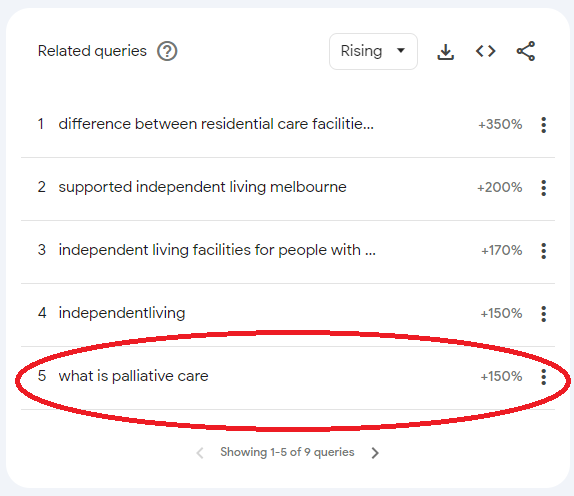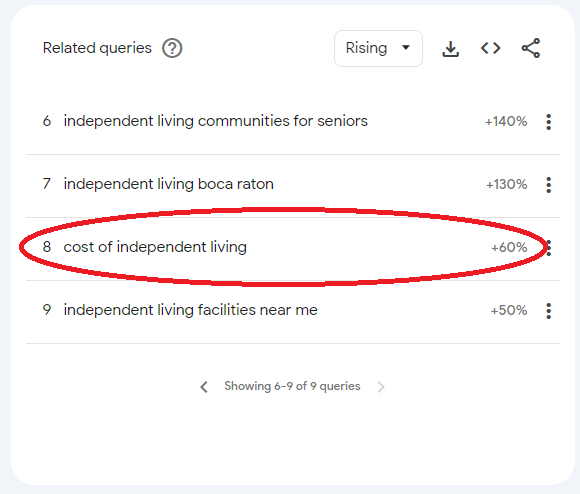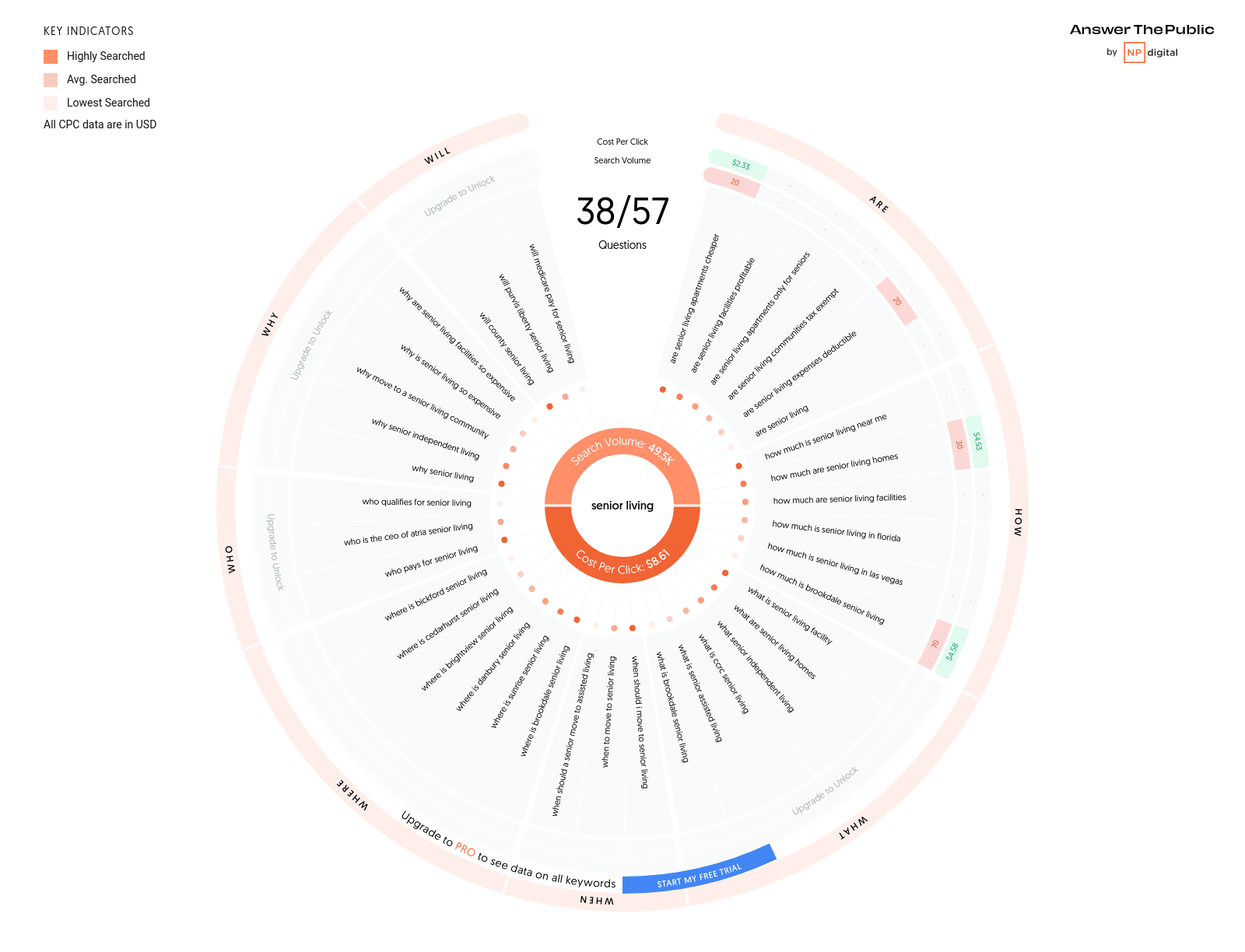Content Brainstorming: Match It to the Prospect Journey

When it comes to content brainstorming, the biggest mistake that senior living marketers make is overlooking the “why.”
Don’t create content just to create content or to check off a box. A chaotic approach like that might have worked fifteen or even ten years ago. But it won’t get you far in an ultra-competitive landscape.
To succeed with content marketing today, you must have a thoughtful strategy guiding your content creation, one that aligns with the buyer’s journey.
Below, we approach content brainstorming by matching it across the three stages of the buyer’s journey: Awareness, Consideration, and Decision. (In senior living, we also talk a lot about the “where, whether, and when” stages since the journey is rarely linear.)
Content Brainstorming for the Awareness Stage
In this stage, people are just starting to become familiar with senior living. Maybe an adult child is looking into options for a parent. Maybe an older adult is thinking about downsizing. Or perhaps an urgent medical condition—a fall or dementia diagnosis, for example—has forced someone to begin researching.
They’re learning what senior living is, what it isn’t, who pays for it, and the different levels of care. They might have had a hazy understanding before entering this stage—maybe in the past they knew someone who lived in a community—but now they’re looking at senior living with a fresh eye.
This is an important stage since people often encounter your community for the first time. Helpful, educational content is critical.
But what if you’ve been writing educational content and feel you’ve already answered every question under the sun?
Here’s where to look for fresh content ideas.
1. See what’s trending—literally—with Google Trends.
Google Trends allows you to see what topics are hot across Google Search, Google News, and YouTube.
We like using the Explore function in Google Trends and occasionally plugging in broad terms like:
- Independent living
- Assisted living
- Memory care
- Senior living
- Retirement
You can certainly come up with plenty of other topics, but if you regularly check the ones above, you might spot a trend worth exploring content-wise.
For example, we explored “independent living.” Here’s what’s trending in related topics.

Notice the query “what is palliative care” is up 150%. We went to Semrush and plugged the phrase into the keyword tool. That query alone is highly competitive, with a monthly search volume of 33K. But when we sorted by keyword difficulty, we got the following, which shows this could be a great long-tail keyword phrase to focus on. You could create an informational blog post or guide (or both) that answers some of these less competitive keyword phrases and discusses how palliative care fits into senior living.

Nope, “what is palliative care” isn’t the sexiest of topics, but consider this:
- It’s a topic people are searching on.
- It’s absolutely related to what your IL community is selling. What happens if someone becomes seriously ill while living in your community? How does palliative care fit in?
Don’t like that topic? No problem. Look at one of the other related topics, like “cost of independent living.” Maybe it’s time to revisit existing assets about funding IL or develop a new guide altogether.

2. Check out AnswerThePublic.
With AnswerThePublic, you can uncover what questions people are searching for in Google. Then, you can create content that answers those questions. Content formats can include:
- Blog posts
- Social media
- Videos
- FAQs
- Lead nurturing emails
- Relevant website pages
By creating a free account on AnswerThePublic, you unlock three daily searches. Here are the results for “senior living.”

Sure, you’ve likely already answered some of these questions in your content. But these questions serve as a reminder that certain queries are evergreen. There will always be people wondering how much senior living costs, whether Medicare covers it, who qualifies for senior living, etc.
Revisit evergreen topics and produce fresh takes.
- You could do something like “Fact or Fiction Friday” on Facebook and set the record straight on some of these common questions.
- You could group a bunch of the Q&As into a blog post.
- You could add them to your FAQ page.
- You could create a one-sheet that the sales reps share with tour attendees.
3. Visit Quora for more authentic conversations people are having about senior living.
Pay attention to how people answer questions on Quora and who’s answering them. You’ll likely see comments from current and former senior living employees, residents, and families.
People on Quora share their candid, authentic insights that can inform content for all stages. These insights can also influence content needed for things like recruitment.
Content Brainstorming for the Consideration Stage
In the consideration stage, people compare options and schedule tours—hopefully with your community.
Make it easy for people to compare.
Create highly visual charts.
At-a-glance comparison charts make it easy to see the differences between your community and your biggest competitors. (Don’t sugarcoat, and never misrepresent your community.)
Encourage residents to share the experiences they’ve had with your community and with other communities.
- Don’t just ask residents or their families why they chose your community—ask them why they didn’t choose your competitor.
- Reach out to residents who moved in from another environment, whether that’s another community, home care, or a family member’s home. Get their take on why the move into your community made sense at this time.
- Ask people to leave reviews about all their experiences with your community—from touring, to moving in, to living in your community.
- Encourage user-generated content where people create their own content and tag your community so you can share/repost (with permission, of course).
How to turn these stories into helpful content:
- Record the person (use your smartphone) and share snippets on social media.
- Do a write-up as a blog post.
- Use the story as a sidebar in relevant guides (for example, “Senior Living vs. Other Options”).
Differentiate your community in the “sea of sameness.”
Think about the stories that would help people wavering between your community and a competitor.
For example, is your move-in day process better than your competitors? If yes, create content around that process:
- Publish a comprehensive website page that discusses the move-in process, what to expect, helpful resources, etc. Need inspo? Look at college websites. They know how to build excitement around moving in.
- Include a call-out to this page on tour confirmation emails. Include a note saying, “We can’t wait to show you around. And even though we might be getting ahead of ourselves, we wanted to show you how easy it is to move into our community.”
Talk about how your community addresses specific elephants in the room.
- Create content around anxiety over moving. Have an honest discussion and provide strategies for effectively managing anxiety.
- Talk about romance and sex. Yes, really.
- Talk about death and dying. Buzz kill or refreshing take? How you write about it is key. Our point: don’t avoid hard topics simply because they’re hard.
Read more ways to differentiate your community.
Content Brainstorming for the Decision Stage
During this stage, people tour and make their final decision.
Elevate the tour experience. (Yes, fabulous content can help!)
We don’t have to tell you how critical tours are. Treat the entire tour “path” accordingly.
- Don’t just have a simple “request a tour” button on your site. Again, take your cue from colleges and create a page that helps people plan their visit. Where should they park? Where should they go upon entering? Who should they ask for? What can they expect during the tour (length, food, etc.)?
- Make it easy for people to schedule tours. Ideally, someone should be able to schedule their desired day and time directly on the page—and receive instant email and/or text confirmation. (It’s 2024, folks. There’s ZERO reason why your site shouldn’t have this functionality.)
- Provide genuinely helpful post-tour content. You should have a follow-up email workflow for people who just attended a tour. Remember, at this stage, people don’t require more education. They already know what senior living is, and they’re familiar with your brand. Instead, focus on content that will speak to them about this monumental decision they’re facing.
o “How I decided” videos/stories. Create a series of videos or stories where residents talk about the moment they decided to choose your community. What was the deciding factor? What was the moment like?
o Tips for deciding between two close contenders. For prospects having trouble choosing between a couple of communities, create a checklist or toolkit (more on this below) that helps them look at the pros and cons.
REMINDER #1: The best content in the world can’t make up for a lousy tour experience—or a community that doesn’t match everything the content has been promoting.
REMINDER #2: Even the most logical among us make decisions based on emotions. (Once we’ve made a decision, we often look for a logical rationale to support it.) Make sure some of the content you create triggers emotional reactions.
For example, you could send a series of emails with built-in emotional triggers:
- “Remember how you felt when you walked through our gardens? Here’s a reminder.” (Include images or a video walk-through.)
- “Remember how wowed you were by our incredible menus? Here’s what our residents recently had for dinner.” (Again, include images or video.)
Create content that empowers people.
At this stage, many people need the courage to sign on the dotted line, so to speak. Create empowering content that helps them do exactly that.
For many of our clients, one of the most powerful pieces of content is a “how to decide” toolkit. People crave guidance, and if you can provide a tool that helps them, even better.
We’ve also created a “What are you waiting for?” campaign for those who’ve stalled post-tour. It’s a highly visual email campaign that reminds people what they could be experiencing if they lived in your community compared to what they’re likely experiencing in their current environment.
For example, in one email, you could have an image of a harried person lugging a laundry basket down to the basement. Next to that image, you’d have a shot of a cheerful staff member handing freshly folded towels to a relaxed resident.
Need more help with content brainstorming?
That’s what we’re here for. We have fabulous content writers and strategists who can help you create winning content that aligns with the prospect journey. Get in touch and let’s talk about your content needs.



